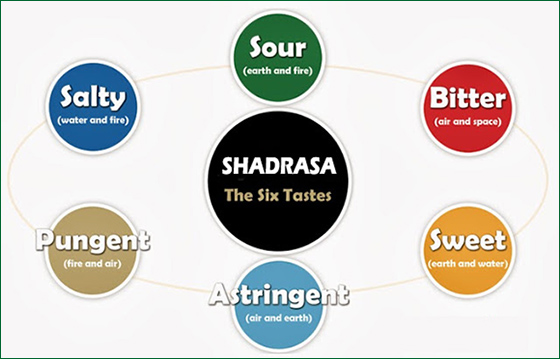In Ayurvedic philosophy, term “rasa” is used for various aspects. Various aspects are discussed briefly for better understanding of rasa with respect to Dravyaguna and medicine.
- Rasa (Taste) : Just as diagnosis of a disease is based on three biological humours (vata, pitta, and kapha) and treatment is based on six tastes (sweet, sour, salt, pungent, bitter and astringent). Our tongue, experiences, tastes when drug is administered, orally. Taste parameter reveals dynamics of Ayurvedic preparations. This description fits within the preview of Dravyaguna, Rasa Shastra and Kaya Chikista.
- Rasa (Plasma) : Here rasa represents the first dhatu (tissue), plasma, which represents bodily fluid including blood, the lymph and interstitial fluids. This description fits within the preview of human physiology.
- Rasa (Parada) : Rasa is used as synonym for parada (mercury), the vital element of Indian Alchemy. This description fits within preview of Rasa Shastra. The word Rasa Shastra literally means the “Science of Mercury”.
- Rasa (Expressed Juice) : Rasa also represents swarasa (Expressed juice of vegetable drugs). Swarasa is part of Panchavidha kashaya kalpana, the basics of Ayurvedic pharmaceutics. This description fits within preview of Bhaishajya Kalpana.
Dravyaguna is an integral part of Ayurvedic curriculum. Dravya stands for the constituents of the universe and guna stands for the property. Study of Dravyaguna revolves around seven parameters (Dravya, guna, rasa, vipaka, virya, prabhava and karma), which are described as the nucleus of Ayurvedic drug formulation.
Dravyaguna deals with the study of drugs derived from nature and Rasa-Shastra deals with study of minerals.
Drug Formulation In Ayurveda Is Based On Following Seven Parameters:
- Dravya (Substance)
- Rasa (Taste)
- Guna (Property)
- Virya (Potency)
- Vipaka (Post-digestion effect)
- Prabhva (Therapeutics)
- Karma (Pharmacological activity)
Dravya is described as a substance used for medicinal purpose. According to Ayurvedic theory, every component of the universe is dravya and has medicinal value. Drugs derived from herbs, minerals and animal source, are included among dravya. Charaka Samhita, the Ayurvedic treatise on medicine, has mentioned dravya to be the nucleus of Ayurvedic pharmacy.
Taste is a fundamental concept of Ayurvedic Medicine but exceptions are always encountered.

Evolution of Tastes
| Taste | Evolution |
| Sweet | Earth + Water |
| Sour | Earth + Fire |
| Salt | Fire + Water |
| Pungent | Fire + Air |
| Bitter | Ether + Air |
| Astringent | Earth+ Air |
Table 1 : Concept of evolution of six tastes
Properties of Tastes
| Taste | Properties |
| Sweet | Moist, cold & heavy |
| Sour | Moist, cold & heavy |
| Salt | Moist, hot & light |
| Pungent | Moist, hot & light |
| Bitter | Dry, hot and light |
| Astringent | Dry, cold & light |
Table 2 : Major properties of six tastes
Composition of Tastes
Water plays important role in the composition of tastes. When interaction of the water element takes place with other elements, the evolution of tastes takes place. The taste of a particular substance depends on the predominance of one of the elements.
Taste and Humours
Enhancing Effect
- Bitter, astringent and pungent increases Vata.
- Sour, pungent and salty increases Pitta.
- Sweet, salt and sour increases Kapha.
Retarding Effect
- Salt, sour and sweet decreases Vata.
- Bitter, astringent and sweet decreases Pitta.
- Pungent, bitter and astringent decreases Kapha.
Taste and Dhatus (Tissues)
- Sweet, sour and salt supplement the body tissues.
- Pungent, bitter and astringent reduces the body tissues.
Taste and Malas (Waste Products)
- Sweet, sour and salt enhance the removal of waste products.
- Pungent, bitter and astringent causes retention of waste products.
Actions of Tastes
- Sweet : Nootropic, demulcent, tonic, expectorant and mild aperient.
- Salt : Laxative, appetiser, digestive, expectorant and emetic (in large doses).
- Sour : Carminative and appetiser.
- Pungent : Stimulant, carminative, diaphoretic, bronchodilator and anthelmintic.
- Bitter : Alterative, anthelmintic, febrifuge, bitter and cholagouge purgative.
- Astringent : Styptic and antidiarrhoeal.
The Evolution, Properties and Functions of Six Tastes have been Summarized Below:
| S.No | Taste | Evolution | Properties | Functions |
| 1. | Sweet | Earth + Water | Moist, cold & heavy | Nutritive, anti-thirst depressant, pacifies vata and pitta |
| 2 | Sour | Earth + Fire | Moist, hot & light | Appetizer, cardiac tonic and nervine tonic |
| 3 | Salt | Fire + Water | Moist, hot & light | Digestive, mild laxative, vata pacifying and sialagouge |
| 4 | Pungent | Fire + Air | Dry, hot and light | Anti-inflammatory, anti-obesity and anthelmintic |
| 5 | Bitter | Ether + Air | Dry, cold & light | Anthelmintic, anti-pruritic and thirst depressant |
| 6 | Astringent | Earth+ Air | Dry, cold & light | Styptic and antidiarrhoeal |
